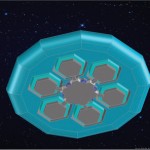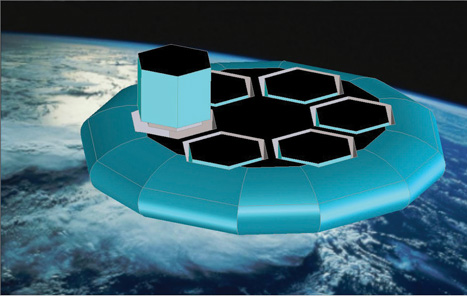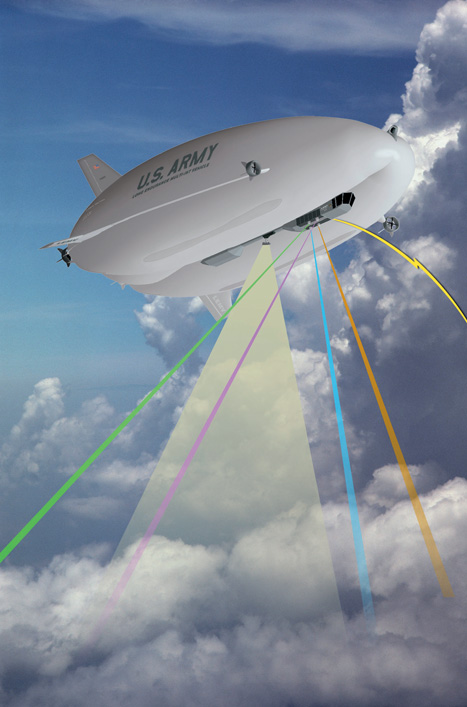14 November 2011 | By Andrew Czyzewski
UK engineers are at the heart of plans to develop a ’cruiser’ airship that could radically change the way goods and people are transported around the world.
It’s official: airships are back. It’s been a long and hard rehabilitation – more than half a century in the making – but they are beginning to be taken seriously again, not simply content with being a footnote in aviation history.
Northrop Grumman’s Long Endurance Multi-intelligence Vehicle (LEMV) hybrid airship, which has significant UK engineering involvement through Hybrid Air Vehicles, is progressing well, with a recent successful scale test flight – albeit with some technical setbacks befitting of any self-respecting aerospace project. Meanwhile, similar projects such as Lockheed’s Martin’s HALE-D and TCOM’s Blue Devil are not far behind.
The military benefits of these airships are obvious: they are essentially unmanned aerial vehicles (UAVs) that can stay up in the sky for weeks at a time, providing continuous surveillance over challenging terrain such as Afghanistan – an ’unblinking eye’, as one member of the LEMV team told The Engineer last year.
In terms of civilian applications, however, it has seemed as if airships might be destined to be confined to tacky advertising and pleasure flights around the shores of Lake Constance – the spiritual home of the original Zeppelin.
But one group of European researchers is convinced of their greater potential and believes, in fact, that an airship-based system could radically change the way we transport goods and people around the globe.
The researchers’ ideas are as far out as they come, but it’s worth dwelling for a moment on the impetus of the project, which is actually a rather dull but important logistical one.
Aviation has undoubtedly transformed society in the past 100 years, bringing major economic and social benefits by effectively ’shrinking the planet’. Yet millions of tons of cargo are transported by thousands of service providers and authorities between hundreds of depots and terminals with little overall co-ordination.
As well as being a wildly inefficient system, its seemingly never-ending expansion is creating environmental problems in terms of emissions and noise, as well as potential safety concerns.
Noting that one of the cornerstones of the European constitution is ’the free movement of people and goods’ across the continent, the European Commission began looking for innovative transport concepts to fund under its Framework Programme 7 (FP-7).
Enter the Multibody Advanced Airship for Transport (MAAT) project, which gathers engineers and researchers with a wide range of specialties from Italy, the UK, Russia, Germany, Belgium, Portugal and Paraguay. The project envisages a ’cruiser’ ship flying at high altitude for long periods (perhaps indefinitely) on a fixed route, along which are set exchange points where feeder or daughter craft take off from the ground and dock with the cruiser.
While this basic ’cruiser-feeder’ concept is not a new one, the use of airships for both types of craft, and the scale of MAAT, is unprecedented.
Prof Paul Stewart of Lincoln University is leading the UK’s contribution to the project, which focuses on the electrical power systems, energy storage, propulsion and control systems used for flight. His background is in tradition civil aviation, specifically designing electrical power solutions to replace conventional hydraulics for the next generation of airliners.
So why switch to airships? ’The project demonstrates all the things that are really attractive about airships – what you can do with them,’ said Stewart. ’You can put an airship station in the middle of the city and you can cut down on all infrastructure costs and all the associated emissions that come from transportation – taking people out of cities – to go on an almost vertical take-off and landing system that can take cargos and people up to this orbiting platform.’
European projects are rated on a scale of zero to 10 based on their technological readiness level (TRL) – where zero is complete blue-skies research and 10 represents market-ready products. The MAAT project is rated as TRL-1, but actually evolved from an earlier project called PSICHE (Photovoltaic Stratospheric Isle for Conversion in Hydrogen as Energy vector), which was rated TRL-0.
Stats
Cruiser airship
Engineers are currently fleshing out the finer details of the MAAT project
- Diameter: 350m
- Height: 70m
- Cruising altitude: 15,600m
- Max Speed: 300km/h
- Power generating capacity: 3-4MW
- Capacity: 510 passengers
- Weight: 500 tons (dry)
- Selling cost: $400m (£250m)
- Annual operating cost: $24m
As Stewart explained, PSICHE essentially involved some ’really hardcore mathematicians of flight dynamics’ at the Southern Federal University in Russia number crunching to see what was in the realms of possibility for a cruiser-feeder system.
The sketches they came up with involved a lenticular-shaped cruiser airship measuring 350m in diameter and 70m in height at the deepest centre point, capable of flying at speeds of around 300km/h at an altitude of 15,600m. This cruiser ship had a total capacity of around 500 passengers and included spaces for six feeder crafts to dock in a flower arrangement around the centre.
’From our calculations, we reckon that the mother ship can supply its own requirements to stay up indefinitely; and, if that’s true, it’s totally radical and consequently opens up a lot of options for transport,’ said Stewart.
And so for the next three years, the aim of the MAAT project will be to flesh out the finer details of the concept with the help of a €5m (£4.3m) FP-7 grant from the European Union. There will be another tranche of money to produce scale models and another to develop the propulsion system.
’It’s almost like being at NASA and putting the Apollo program back together again but with airships – you’re going all the way with multiple bodies, docking procedures, safety… self-power,’ said Stewart. ’NASA didn’t start with a fully fledged spaceship; it worked up through the Mercury Project and the other projects. It knew the Type 5 would work – Wernher von Braun delivered the calculations back in the 1940s. All they [NASA] did was fill in the gap between the maths.’
Both the cruiser and the feeder craft will be semi-rigid, employing the same hybrid principles as the current crop of advanced military airships. They will therefore use both aerostatic lift like a conventional airship, from the lighter-than-air gas that fills the envelope, and the aerodynamic lift generated by the shape of the semi-rigid advanced composite woven hull. Thrust vectoring will also be employed for propulsion and overall stability.
Photovoltaic panels will be the sole source of power for the various electronics and power systems. In addition, water brought up from feeder craft will be electrolyzed to produce hydrogen, some of which will be fed into ballonets to produce controllable buoyancy, while the rest will go into storage for later use in hydrogen fuel cells. Heat from the solar panels will also be used to generate energy from combined heat and power (CHP) systems.
The MAAT collaborators envisage a scenario where there are 12 feeder craft (six on the ground and six joined to the cruiser). The cruiser ship will arrive with people and goods at an interception point and the feeder containing them will be released and will descend to land at an airport hub – from which another feeder with people and goods will have previously taken off to be boarded on the cruiser.
After reaching the operational altitude of the cruiser ship, the feeder approaches and engages in the place vacated by the descending feeder using aerostatic lift and thrust vectoring. The complete MAAT system will proceed to the next interception point, where the unloading/loading procedure will be repeated. In terms of safety, if some of the ballonets were to fail, the buoyancy system would not be irremediably damaged and the cruiser ship could safely reach lower altitudes (some thousands of meters) with a fall speed much lower than that of any aircraft encountering problems.
It is usual practice in an interview to ask an engineer what the main technical challenges of a particular project might be, but in the case of MAAT it’s difficult to know where to start. ’It’s a fairly substantial little power station in the sky,’ said Stewart. ’You’ve got to handle 4MW and that’s not cheap in terms of resources and weight. There are fundamental questions to ask just in power generation and distribution. Do you generate DC? Do you convert it to AC? Every time you convert energy, you pay a weight penalty of some description – it’s a massive optimization problem.
’The weight of the power system and the weight of the photovoltaics will be very challenging indeed. From a materials point of view, making that airship rigid is an amazing task. But that’s always the challenge of doing anything in the air: how do you make it rigid yet light? It’s the same problem that the Wright brothers faced at Kitty Hawk: how do you make the wings and structure rigid yet light enough and how do you make the power system light enough to get off the ground? Physics never changes.’
And it’s a problem the team is now committed to overcome, at least at a reduced 1:10 scale. The researchers will launch a cruiser ship with the propulsion system, currently in development, and send it up to high altitude somewhere near the planned 15km. They also plan to make some sort of demonstration of the docking mechanism required for the cruiser-feeder element.
Indeed, Stewart said that that the project is not just a thought experiment and will have concrete outcomes – pointing towards the ’hoops we had to jump through in justifying the concept’ and securing the initial funding. Nevertheless, he added that the MAAT project might foster the development of spin-out technologies, even if the system in its entirety isn’t realized.
’Some people miss the point of these projects,’ said Stewart. ’We obviously want to deliver something that works; however, if it’s a good project, it will chuck up more questions than it answers. Can we send something up there just to make hydrogen and bring it down to Earth? Could you live up there? How far up could you live? Could you grow food up there?’
In addition, Stewart said that an important part of the project will be public engagement and trying to engender interest in engineering and technology in a similar way that the Bloodhound land-speed record attempt is trying to do. As someone who initially studied politics at university then came into engineering through an apprenticeship, Stewart is also rather uniquely qualified to comment on the state of the industry in the UK. ’We’re massively short of engineers in this country; everyone knows that. It’s a job we have to do as universities to hopefully engage young people in projects such as MAAT and in doing fun stuff such as airships.’
While Stewart believes the UK is doing some good work in terms of technology application through TSB- and EPSRC-funded projects, he said more could be done for basic research. ’I never thought I’d say this about Europe, but it’s kind of one of the great hopes for proper cutting-edge blue-sky research in this country. There’s no way you’d get this project funded by one of the research councils in this country, because it’s too risky, too adventurous, even for funding bodies who claim to represent adventure and risk.’
Staying in control of the vehicle
Dr Paul Stewart believes the issue of instability can be overcome using thrust vectoring technology.
Giving a talk recently on the MAAT project at the Airship Association’s 36th Annual Symposium, Dr Paul Stewart fielded questions from the members – mostly engineers and airship veterans of many decades. While most welcomed such a radical way of thinking and the revival of airships in general, there were some testing questions on flight dynamics and dreaded Reynolds numbers.
’This lenticular shape… some of us have tried it before and it’s grossly unstable,’ one member said. The problem, apparently, is that lenticular airships start to list from side to side, eventually entering oscillating limit cycle. One airship engineer, Dr Edwin Mowforth, experimented with lenticular airships in the 1980s with the now defunct British company Airship Industries. The concept was eventually dropped, with Mowforth publishing some calculations suggesting it was all but impossible to control.
Stewart countered: ’Instability’s no bad thing. Combat aircraft rely on instability – the F-16 is unflyable by any human… You have to do it with computer control and fly-by wire.’
Indeed, MAAT will use thrust vectoring technology in a bid to overcome this instability. Thrust vectoring refers to the ability to manipulate the direction of the thrust from engines to control the attitude or angular velocity of the vehicle.
’If you’ve ever been to an air show and seen a MiG-29 or an SU-27 do the cobra maneuver, where it flips on its back, that’s done by thrust vectoring,’ said Stewart.
Another problem facing the MAAT project is that at high altitude the air is far less dense and therefore it’s difficult for conventional propellers, even at high speed, to grasp enough air to get the reactive forces needed for forward propulsion.
The propulsion system of MAAT is currently going through a patent process, so Stewart could not elaborate on its precise design. However, he did point towards some all-electric jet engines currently in development, including EADS’ VoltAir concept, which incorporates superconducting materials.
Source: theengineer.co.uk




